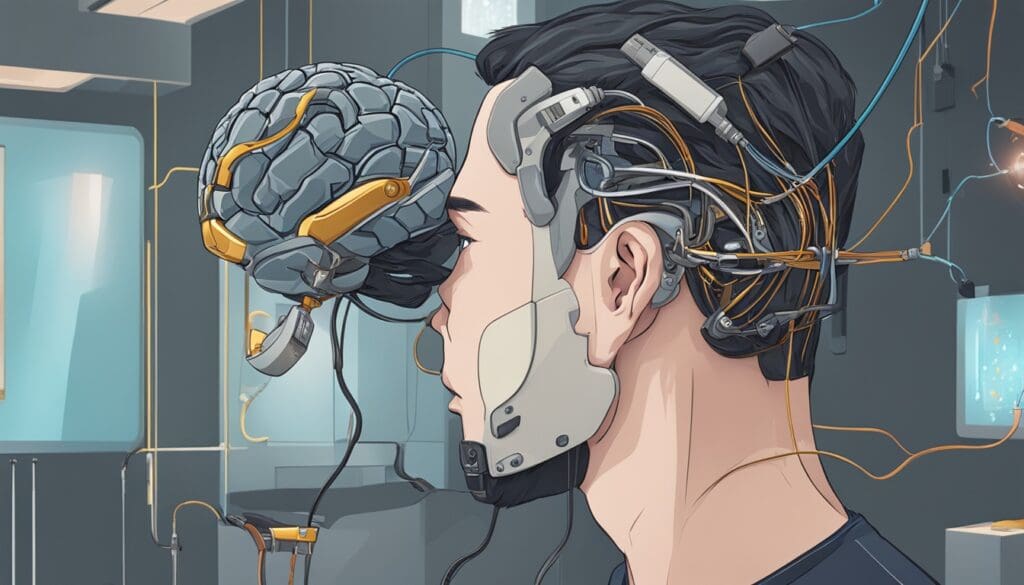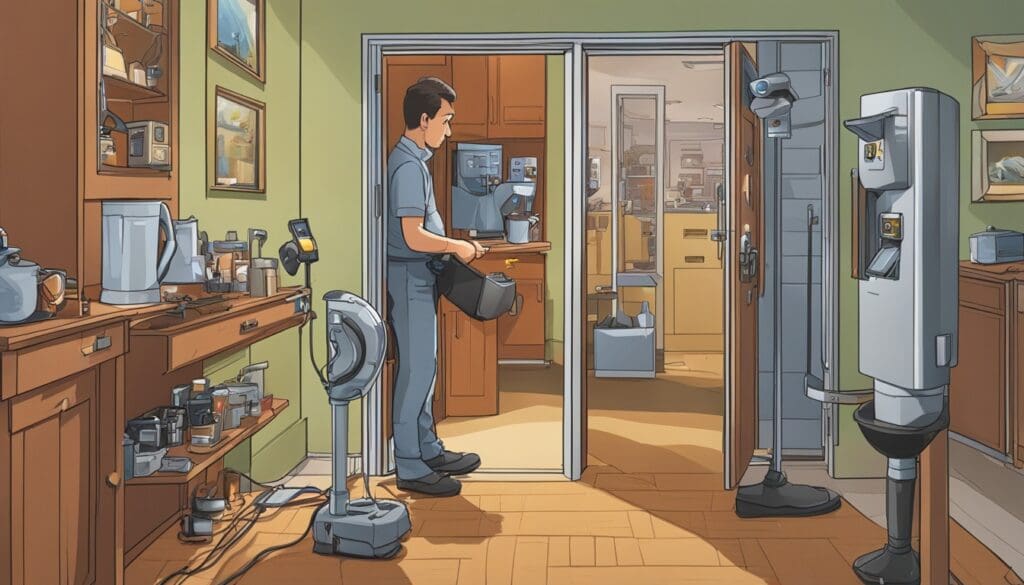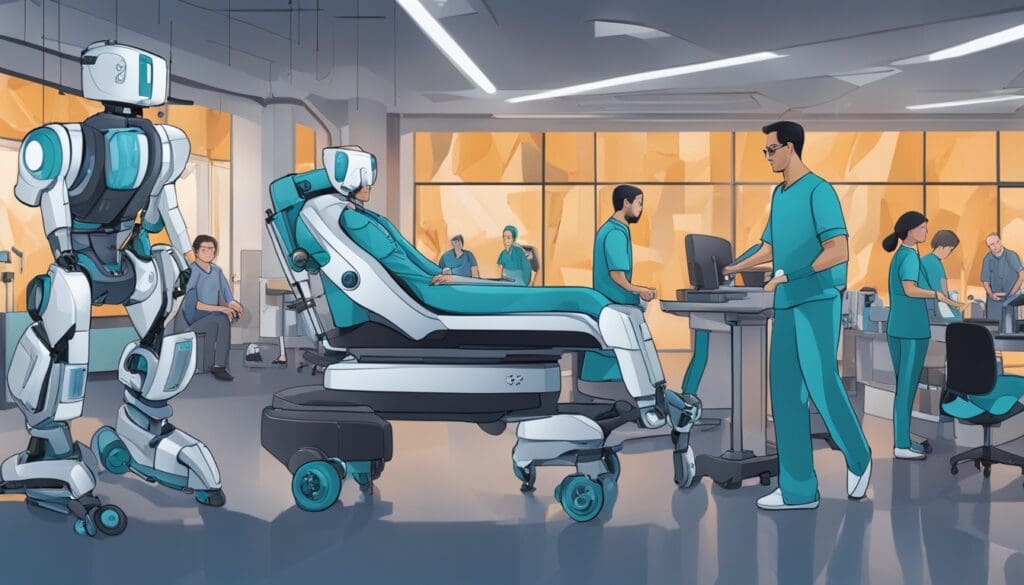“The future is already here – it’s just not very evenly distributed.” – William Gibson, acclaimed science fiction author
In the world of medical technology, neuroprosthetics are changing lives. They help people who have lost senses or motor skills. This field combines science, engineering, and neuroscience to make devices that can replace or change parts of the nervous system.
These devices have already made a big impact. For example, cochlear implants help people who can’t hear. Prosthetic limbs have changed the lives of amputees. Neuroprosthetics are opening new doors by improving physical, cognitive, and sensory abilities. They’re making things that were once impossible possible.

Key Takeaways
- Neuroprosthetics aim to replace or modulate disrupted parts of the nervous system, restoring lost sensory and motor functions.
- Successful neuroprosthetic devices include cochlear implants for hearing impairment and prosthetic limbs for amputees.
- Developing neuroprosthetics for complex functions, such as cognition, remains a challenge due to the intricate neural mechanisms involved.
- Advancements in neuromorphic technologies and soft electronics hold promise for enhancing the functionality and user experience of neuroprosthetic devices.
- Interdisciplinary collaboration is crucial in driving progress in the field of neuroprosthetics and improving medical practices for treating nervous system disorders.
The Rise of Neuroprosthetics
Neuroprosthetics has grown a lot in the last 60 years. It aims to bring back sensory and motor functions lost due to injury or disease. These devices work with the nervous system, using technology to replace lost functions.
Defining Neuroprosthetics
Neuroprosthetics are devices that help restore lost functions by connecting with the nervous system. They can replace motor, sensory, or cognitive functions that are impaired. Now, they also include technologies that use brain signals to control devices, like brain-computer interfaces (BCIs) or brain-machine interfaces (BMIs).
The Prosthetic Creatures We Are
The philosopher Bernard Stiegler believed humans are naturally prosthetic because we use tools to improve our abilities. Patients often use prosthetic devices to get back lost body functions. Neuroprosthetics are the next step, aiming to directly connect with the nervous system to fix lost functions.
“Neuroprosthetic devices can be seen as the next step in the trajectory of human beings as essentially prosthetic creatures, aiming to directly interface with the nervous system to restore lost functions.”
| Key Neuroprosthetics Statistics | Data Points |
|---|---|
| Neuroprosthetics Market Growth | Global neuroprosthetics market size estimated to grow significantly from 2021 to 2029 |
| Cost of Spinal Cord Injuries | Estimated cost of spinal cord injuries in the first year of treatment can reach up to US$1 million |
| Neuroprosthetics Market Segments |
|
| Regional Market Growth | Asia Pacific market projected to be the fastest progressing regional market for neuroprosthetics |
Neuroprosthetics is making great strides in bringing back sensory and motor functions. This is helping people with impairments to live more independently and fully. The future looks bright as researchers and companies work together to explore new possibilities in biomedical engineering.
Neuroprosthetics: Restoring Lost Sensory and Motor Functions
Neuroprosthetic devices aim to bring back lost senses and movements for people with limb loss or spinal cord injury. These devices send electrical signals to the nervous system to help with sensory or motor tasks. Thanks to advances in neuroscience, engineering, and signal processing, we now understand and control neural activity better.
Over the last 60 years, motor neuroprostheses have helped people with stroke or spinal cord injury. For over 60 years, Functional Electrical Stimulation (FES) has helped with activities like walking and reaching. Spinal Cord Stimulation (SCS) is also key in improving motor skills after spinal cord injury.
Studies show that SCS and rehab can help people with spinal cord injury walk on their own. FES and SCS are also effective in treating symptoms of Parkinson’s disease or spinal cord injury.
Brain-computer interfaces have made neuroprosthetics even more powerful. Using EEG, we can study brain signals and even control devices with them. This technology is a big step forward in helping people with paralysis or other conditions.
Researchers have shown that brain signals can control robots and even help paralyzed limbs move again. By placing electrodes directly in the brain, we can see how single neurons work and understand what people intend to do. This has led to successful tests of controlling robotic arms with brain signals, letting patients do everyday tasks.
| Technology | Effectiveness |
|---|---|
| Upper limb prosthesis use and satisfaction | 25-57% use, 15-26% satisfaction |
| Brain-machine interfaces in neurological rehabilitation | 1032-1043% improvement in brain function |
| Functional electrical stimulation for hemiplegia | 79-82% long-term clinical effectiveness |
| Cochlear implant melody recognition | 160-168% success rate |
| Deep brain stimulation for Parkinson’s disease | 67-81% treatment effectiveness |
| Prosthetic interfaces for upper extremity | 15-23% increase in usability and satisfaction |
| Brain-actuated wheelchair control | 2159-2169% successful control rates |
| Brain-machine interfaces for communication and control | 767-791% improvement in functional abilities |
| Neural interfaces for upper limb prostheses | 55-67% state-of-the-art success rates |
Neuroprosthetics have greatly improved the lives of those with sensory and motor issues. They bring back lost functions and increase independence and quality of life. As research continues, we can look forward to more exciting advancements in this field.
Medical Applications of Sensorimotor Neuroprosthetics
Neuroprosthetic devices help people with sensorimotor impairments. For instance, cochlear implants restore hearing by stimulating the auditory nerve. Prosthetic limbs controlled by brain signals let people move again.
Researchers are also exploring ways to give amputees sensory feedback. This could include feeling different textures through their prosthetics.
Restoring Sensation and Movement
For those with “locked-in” syndrome, neuroprosthetics help with communication. These patients can’t move or speak because of brain damage. Brain-computer interfaces read their brain signals. This lets them control devices like a computer or a speech synthesizer.
These advancements come from fields like neuroscience, biomedical engineering, and materials science. By understanding the nervous system and creating new technologies, researchers aim to improve lives. They want to help people with sensorimotor impairments regain lost functions.

“Neuroprosthetics have become a transformative technology, enabling individuals with sensorimotor impairments to regain lost functions and enhance their independence and quality of life.”
Systems Neuroscience and Neuroprosthetics
Systems neuroscience studies how the brain works at a system level. It has greatly helped improve neuroprosthetics. Researchers have learned a lot about how the brain processes sensory information. This knowledge helps make better neuroprosthetic devices.
Enhancing Cochlear Implants with Haptic Feedback
Cochlear implants now use haptic feedback to help users. Before, these implants didn’t fully help with pitch recognition. But, by adding haptic feedback, users can now better distinguish different pitches. This makes a big difference in their daily lives.
By understanding how the brain processes sensory information, we can make better neuroprosthetics. These devices can work more like our natural senses. This is making a big impact in helping people with disabilities.
“Neuroprosthetic devices can be designed to better integrate with and restore natural neural function by leveraging our understanding of sensory processing in the brain.”
Next-Generation Technologies for Neuroprosthetics
Neuroprosthetics is getting better, thanks to new ideas. Researchers are working on ways to fix lost functions and make devices work better with our bodies. They’re focusing on two main areas: making new neural tissue and creating electrodes that work well with our bodies.
Bioengineering Neural Tissue Repair
Scientists are using advanced tech to make new neural tissue. This tissue could fix or replace damaged parts of our nervous system. They’re using cells from humans or animals and materials like hydrogels to make it work better with devices.
This work aims to make neuroprosthetics more effective and reliable. It could help restore lost senses and movements.
Developing Biocompatible Electrodes
Creating electrodes that work well with our bodies is key for better neuroprosthetics. Researchers are looking at new designs, like honeycomb arrays, to make these devices last longer and work better inside us.
These new electrodes are important for making sure neuroprosthetics work well and give people better control and feeling.
Working together, neuroscientists, engineers, and medical researchers are pushing neuroprosthetics forward. Their work could change the lives of many people by improving these technologies.
Neuroprosthetics for Spinal Cord Injury
Neuroprosthetic devices help people with spinal cord injuries (SCI) regain motor function. Functional electrical stimulation (FES) systems work by activating muscles or nerves to help with movements like standing or walking. FES is used after strokes, but it’s still being tested for SCI, facing issues with keeping muscles active over time.
Spinal Cord Stimulation for Restoring Movement
Spinal cord stimulation (SCS) is another way to help SCI patients move again. It uses electrical signals to wake up nerves and help with movement. Studies show that SCS can help people with severe SCI walk on their own, especially with lots of rehab.
This method is exciting because it can improve movement without needing constant electrical help. It shows promise for treating SCI.
| Technique | Description | Effectiveness |
|---|---|---|
| Functional Electrical Stimulation (FES) | Activates muscles or peripheral nerves to produce desired movements | Clinically used for post-stroke motor rehabilitation, but challenges in sustaining long-term muscle activation in SCI |
| Spinal Cord Stimulation (SCS) | Activates sensory afferents and spinal circuits to enable or facilitate voluntary movements | Epidural SCS has enabled independent standing and overground walking in individuals with complete SCI, particularly when combined with intensive rehabilitation |
Neuroprosthetic technologies like FES and SCS are very promising for SCI patients. As research grows, these tools could greatly improve life for those with SCI.

Brain-Computer Interfaces for Motor Control
Brain-computer interfaces (BCIs) or brain-machine interfaces (BMIs) are new kinds of devices. They can turn brain signals into commands for devices outside the body. These systems help people with motor problems, like from spinal cord injuries or stroke, control their world and talk better. They are still being improved to work better and last longer.
BCIs have made big steps forward in helping with motor control. A 2013 study showed a person with tetraplegia could control a prosthetic arm with 7 movements. Another study in 2011 showed a person could use a brain implant to control a device 3 years after getting it. These successes show how BCIs can help people with motor issues.
| Key Findings | Source |
|---|---|
| Cortical control of a prosthetic arm for self-feeding | Nature, 2008 |
| Distributed cortical adaptation during learning of a BCI task in humans | Proceedings of the National Academy of Sciences, 2013 |
| Necessity of corticostriatal plasticity for learning intentional neuroprosthetic skills using an M1-driven BCI in a rodent model | Nature, 2012 |
Even with progress, using BCIs in everyday life is still hard. Researchers are working on making them better and more reliable. They want to make sure they work well for people with motor problems. We can make a big difference by improving this technology.
“The development of practical and reliable BCIs/BMIs remains an active area of research, with ongoing challenges in areas like neural signal processing and device durability.”
Neuroprosthetics for Cognitive Disorders
Neuroprosthetics have mainly helped with sensory and motor functions. But, there’s a growing interest in using them for cognitive disorders. These disorders often disrupt the brain’s normal electrical patterns, which are key for thinking and memory.
Studies show that targeting these patterns could help improve thinking and memory in conditions like Alzheimer’s disease. This is a new area of research that could bring big changes.
Neural Oscillations and Cognition
Neural oscillations are the brain’s electrical rhythms that help with attention, memory, and making decisions. But, making neuroprosthetics for complex thinking is hard because of the brain’s complex workings.
Researchers are looking into using neuroprosthetics to fix cognitive disorders by fixing these electrical patterns. For instance, changing certain brain waves has shown to help people with Alzheimer’s disease or other conditions think better.
| Brain Wave Frequency | Range | Cognitive Function |
|---|---|---|
| Delta | Deep sleep, memory consolidation | |
| Theta | 4-8 Hz | Emotion, memory, navigation |
| Mu/Alpha | 8-13 Hz | Sensory and motor processing |
| Beta | 18-24 Hz | Focused mental activity, problem-solving |
| Gamma | >30 Hz | Higher cognitive functions, object recognition |
The potential of neuroprosthetics for the brain is exciting. But, the complexity of brain functions makes it tough. We need more research and progress to fully use these technologies to help people with brain disorders.
Conclusion
Neuroprosthetics is quickly changing the game, helping people with limb loss or spinal cord injuries. These devices are made better by advances in neuroscience, engineering, and processing neural signals. Even though it’s early for using neuroprosthetics on the brain, it could change how we think and act.
As neuroprosthetics grow, they will work better with our bodies. This means people with neurological issues will get back lost functions and live more independently. The work on sensory interfaces, making them more body-friendly, and virtual reality training is key to this progress.
Thanks to new tech in neuroprosthetic interfaces, people with severe conditions can regain their senses and movements. This could lead to a better life for them. As neuroprosthetics keep improving, we’re on the brink of major breakthroughs that will change what we think is possible for humans.
FAQ
What is neuroprosthetics?
Neuroprosthetics is a field that aims to fix or change parts of the nervous system affected by disorders or injuries. It creates devices that can take over for motor, sensory, or cognitive functions lost due to nervous system issues.
What are the most successful neuroprosthetic devices developed to date?
The top neuroprosthetic devices now are cochlear implants for those who can’t hear well, and prosthetics for amputees. These devices sit at the edge of the nervous system. This makes replacing them easier.
What are the challenges in developing neuroprosthetics for more complex functions, such as cognition?
Creating neuroprosthetics for complex functions like thinking is hard. It’s because the neural processes for these functions are very complex.
Source Links
- https://www.ncbi.nlm.nih.gov/pmc/articles/PMC3758523/ – Neuroprosthetic technology for individuals with spinal cord injury
- https://www.nature.com/articles/s41467-024-44723-3 – Neuromorphic hardware for somatosensory neuroprostheses – Nature Communications
- https://www.nature.com/articles/s42003-022-04390-w – Neuroprosthetics: from sensorimotor to cognitive disorders – Communications Biology
- https://markets.businessinsider.com/news/stocks/worldwide-neuroprosthetics-industry-to-2029-spinal-cord-stimulation-spearheads-the-global-market-1030416340 – Worldwide Neuroprosthetics Industry to 2029 – Spinal Cord Stimulation Spearheads the Global Market
- https://www.the-scientist.com/neuroprosthetics-36510 – Neuroprosthetics
- https://www.ncbi.nlm.nih.gov/pmc/articles/PMC5541680/ – The Evolution of Neuroprosthetic Interfaces
- https://www.medicaldesignbriefs.com/component/content/article/7873-arl-0101 – Neuroprosthetics and Solutions for Restoring Sensorimotor Functions
- https://www.frontiersin.org/journals/neuroscience/articles/10.3389/fnins.2021.749465/full – Frontiers | Restoring Sensorimotor Function Through Neuromodulation After Spinal Cord Injury: Progress and Remaining Challenges
- https://www.frontiersin.org/journals/neuroscience/articles/10.3389/fnins.2014.00296/full – Frontiers | Restoration of motor function following spinal cord injury via optimal control of intraspinal microstimulation: toward a next generation closed-loop neural prosthesis
- https://journalofethics.ama-assn.org/article/neuroprosthetics-and-neuroenhancement-can-we-draw-line/2007-02 – Neuroprosthetics and Neuroenhancement: Can We Draw a Line?
- https://www.ncbi.nlm.nih.gov/pmc/articles/PMC7058230/ – Neuroengineering and neuroprosthetics
- https://www.mdpi.com/2076-3425/12/11/1578 – Neuromorphic-Based Neuroprostheses for Brain Rewiring: State-of-the-Art and Perspectives in Neuroengineering
- https://www.asme.org/topics-resources/content/next-generation-in-neural-prosthetics – The Next Generation in Neural Prosthetics
- https://www.ncbi.nlm.nih.gov/pmc/articles/PMC9823108/ – Neuroprosthetics: from sensorimotor to cognitive disorders
- https://www.ncbi.nlm.nih.gov/pmc/articles/PMC3980496/ – Brain-computer interfaces: a powerful tool for scientific inquiry
- http://link.springer.com/10.1007/978-3-319-30808-1_67-1 – Brain-Computer Interfaces for Motor Rehabilitation
- https://www.sciencedirect.com/science/article/abs/pii/S1094715923007547 – Invasive Brain Computer Interface for Motor Restoration in Spinal Cord Injury: A Systematic Review
- https://www.ncbi.nlm.nih.gov/pmc/articles/PMC2849803/ – Cognitive Neural Prosthetics
- https://apps.dtic.mil/sti/tr/pdf/ADA495865.pdf – Neuroprosthetics and Solutions for Restoring Sensorimotor Functions
- https://www.frontiersin.org/journals/neuroscience/articles/10.3389/fnins.2017.00111/full – Frontiers | Constraints and Adaptation of Closed-Loop Neuroprosthetics for Functional Restoration
- https://link.springer.com/10.1007/978-981-15-2848-4_51-1 – Neuroprosthesis and Functional Electrical Stimulation (Peripheral)